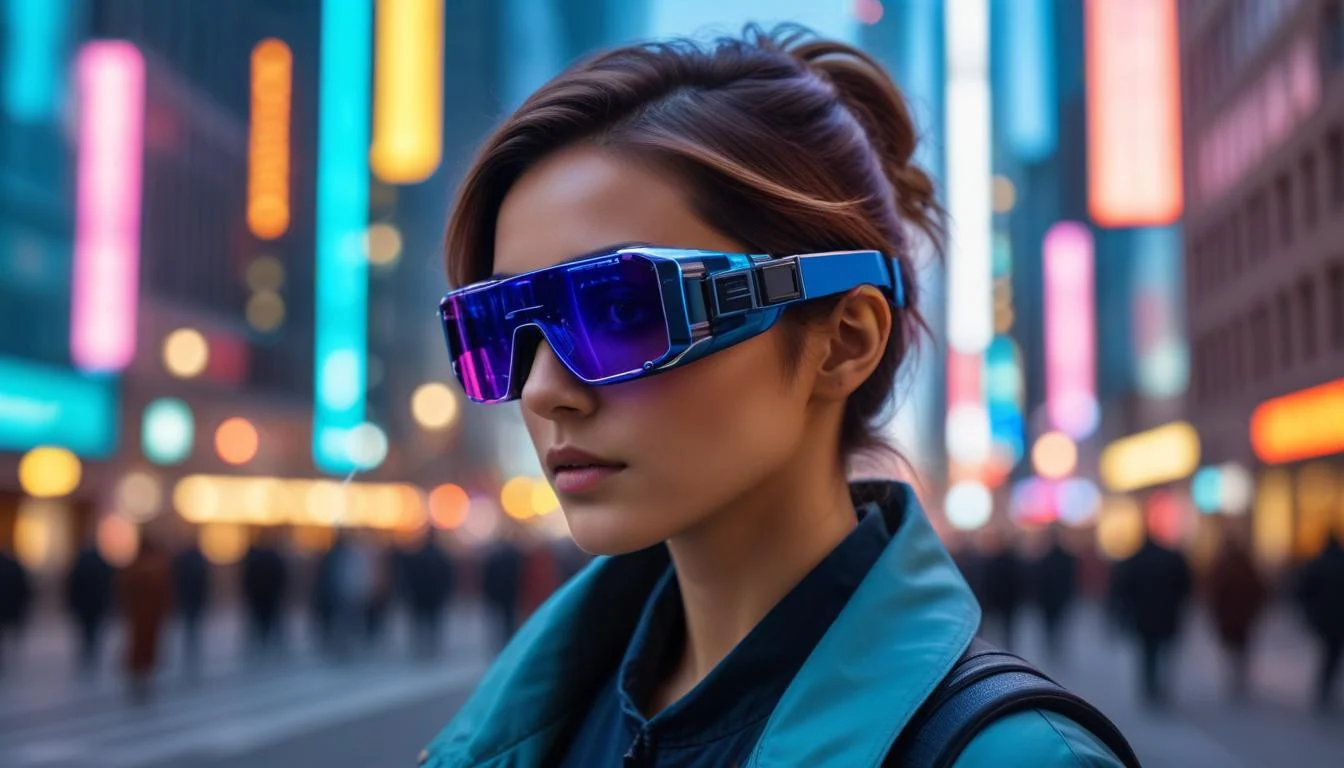 🔔 Affiliate Disclosure
This content may contain affiliate links. If you click on a link and make a purchase, we may receive a small commission — at no extra cost to you. Thank you for supporting BeatInsights! 💛
🔔 Affiliate Disclosure
This content may contain affiliate links. If you click on a link and make a purchase, we may receive a small commission — at no extra cost to you. Thank you for supporting BeatInsights! 💛
Imagine glancing at a restaurant and seeing its menu and reviews overlaid right before your eyes. Envision navigating a new city with directions appearing directly on the sidewalk. This is the promise of augmented reality (AR) glasses. Meta, after its initial experiments in the AR/VR space with the Ray-Ban Meta smart glasses and various prototypes, aims to make this vision a reality. This article will explore the features of the Meta AI Glasses 2025, the potential impact of augmented reality glasses with AI assistant, and the future possibilities of AR glasses for professional use. We will consider advancements in artificial intelligence (AI) and AR tech that could power the Meta augmented reality glasses future along with how AI powered smart glasses 2025 are likely to function.
What Are Meta AI Glasses 2025?
These Meta Ai Glasses 2025 are envisioned to be more than just smart glasses. The “AI” aspect is key. It signals a shift towards proactive assistance. They will use AI to understand your context and provide relevant information. This is a move beyond simple notifications. It aims to offer a truly intelligent, personalized experience.
Rumored Specs and Design
The design could prioritize lightweight materials. Battery life is a crucial consideration. MicroLED or waveguide tech might power the displays. Partnerships with display manufacturers could be vital. For example, Meta could collaborate with companies like Plessey. These potential AI powered smart glasses 2025 must be stylish too.

Target Audience for These Meta Augmented Reality Glasses Future
Who will buy these Meta augmented reality glasses future? Early adopters are a likely target. Professionals who need hands-free information access are another group. Meta may also aim for the general public, making the glasses accessible and user-friendly. Achieving mass adoption is a long-term goal.
Key Features and Functionality of AI Powered Smart Glasses 2025
These Meta Ai Glasses 2025 will offer many functions. AI is central to their operation. AR overlays will enhance the user experience. Seamless connectivity will keep users connected.
AI-Powered Assistant
A built-in AI assistant is expected. It should use natural language processing. Context awareness will be crucial for personalization. The assistant will learn your preferences over time. It could proactively offer help. For instance, it may suggest alternate routes during traffic.
AR Overlays and Visual Information
Information display is a core feature. Real-time translation could be invaluable for travel. Object recognition might identify plants or landmarks. Navigation should be intuitive and seamless. Imagine seeing turn-by-turn directions overlaid on the road. This kind of functionality makes augmented reality glasses with AI assistant very attractive.
Connectivity and Communication
These glasses should integrate well with Meta’s ecosystem. Integration with messaging and social media is likely. Phone calls could be hands-free. They should connect to other devices easily. This connectivity will improve the user experience.
Advanced Sensors and Data Collection
Eye-tracking could enable new interaction methods. Gesture recognition may allow for hands-free control. Environmental awareness will help the glasses understand their surroundings. Meta must address privacy implications carefully. Transparency about data collection is important.
The Technology Behind the Magic of Augmented Reality Glasses with AI Assistant
Several technologies power these advanced glasses. Advances in AI are very important. AR technology provides the visual experience. Powerful chipsets handle the processing. Software ties everything together.
Advancements in AI
AI will drive personalization. Machine learning will improve the AI assistant. Computer vision will enable object recognition. Personalized recommendations will make the glasses feel tailored. This makes the Meta augmented reality glasses future very promising.
Augmented Reality Technology
Micro-displays create the AR visuals. Waveguides project images into the user’s eyes. Spatial computing maps the environment. This allows for accurate AR overlays. The combination is essential for a convincing AR experience.
Chipset and Processing Power
The glasses will need powerful processors. Energy efficiency is crucial for battery life. Qualcomm is a potential chip supplier. Qualcomm makes chips for many AR devices. The processor should handle AI tasks and AR rendering smoothly.
Software and Operating System
The operating system is likely a custom version of Android. Meta may develop a new platform. The software must be optimized for AR. It should be intuitive and responsive. Updates will add new features and improvements.
Potential Applications and Use Cases of AR Glasses for Professional Use
The glasses have broad applications. They can help with everyday tasks. Also, they can aid professionals in their work. These Meta Ai Glasses 2025 are designed to do more than just entertain.
Everyday Life
Navigation becomes easier with visual directions. Communication is hands-free and seamless. Entertainment can be more immersive. Shopping could be enhanced with product information overlays. Social interaction might involve shared AR experiences.
Professional Use
Remote collaboration gets a boost. Training becomes more interactive and engaging. Field service technicians can access information hands-free. Healthcare could use AR for surgery and diagnostics. This is one of the most promising facets of the Meta augmented reality glasses future. With AI and AR, the possibilities are almost endless.
The Meta Ai Glasses 2025 promise to reshape how we interact with the world. These AI powered smart glasses 2025 aim to blend the digital and physical. Imagine AR glasses for professional use, offering hands-free access to information. Consider the Augmented reality glasses with AI assistant providing real-time support. The Meta augmented reality glasses future hinges on innovative features.
Education and Immersive Learning
AR glasses can change education. Interactive learning experiences become possible. Personalized tutoring is within reach. Virtual field trips could transport students anywhere. Students could explore ancient Rome or the Amazon rainforest, all from their classroom. This immersive approach can make learning more engaging and effective. Imagine dissecting a virtual frog without the mess. Consider learning a new language through interactive simulations.
AR can also help people with disabilities. It provides real-time information and support. For example, glasses can translate speech into text for the hearing impaired. They can also describe surroundings for the visually impaired. This technology enhances independence. AR can also offer navigation assistance. It can help users avoid obstacles.

Social and Economic Impact
How might Meta Ai Glasses 2025 affect society? Will they change how we communicate? These glasses might affect face-to-face communication. Social norms could change. Will people focus more on their screens than on each other? Only time will tell. However, new job opportunities will arise.
The economic impact of AR is substantial. New jobs will emerge in software development. There will be more jobs in hardware manufacturing and content creation. Existing industries may also see disruption. Retail, healthcare, and manufacturing could change. This could lead to both gains and losses.
Ethical concerns are vital. Privacy is a key issue. Data security must be protected. Bias in AI algorithms is a risk. Misuse of the technology is possible. Thoughtful regulation is needed to protect users. The Electronic Frontier Foundation advocates for digital rights.
Meta’s vision for the Metaverse includes AR glasses. The Metaverse is a shared virtual space. AR glasses can act as a portal to this space. Users can interact with digital objects. They can also connect with other users. This integration creates new social and economic opportunities.
Technical and Adoption Hurdles
Several technical hurdles remain. Battery life is a major concern. Display technology needs improvement. Processing power must increase. Heat dissipation is also important. Solving these challenges is vital for widespread adoption.
User adoption depends on several factors. Price is a significant barrier. Comfort is also important. Social acceptance is crucial. Privacy concerns must be addressed. If Meta Ai Glasses 2025 are too expensive or uncomfortable, people will not buy them.
Regulatory issues also present challenges. Data privacy laws must be established. Safety standards are needed. The potential for misuse must be addressed. Governments around the world are considering these issues. NIST is working on AI standards.
Competition in the AR market is intense. Apple and Google are developing their own glasses. Other companies are also entering the market. This competition will drive innovation and lower prices. The outcome is hard to predict.
Future of Augmented Reality
The long-term vision for AR is ambitious. AR could transform how we live, work, and play. It could become as common as smartphones. However, this will take time and effort. Meta augmented reality glasses future depends on innovation.
Integration with other technologies is crucial. AI will power many AR features. The Internet of Things (IoT) will provide data. 5G and 6G will enable faster connections. Quantum computing could enhance processing power.
The evolution of AR glasses is ongoing. Miniaturization is key. Performance must improve. New features will be added. The goal is a truly immersive experience. This will blur the line between the digital and physical.
The potential for a seamless AR experience is vast. Imagine a world where information is always available. Imagine interacting with digital objects naturally. This is the promise of augmented reality. The AI powered smart glasses 2025 bring us closer to this vision.
Conclusion
Meta Ai Glasses 2025 offer potential benefits and risks. These glasses could transform education and communication. They could create new economic opportunities. However, ethical considerations must be addressed. Regulatory issues also need attention. The Meta Ai Glasses 2025 and AR glasses for professional use represent a big step toward the Augmented reality glasses with AI assistant, highlighting the transformative potential of AR technology. The Meta Ai Glasses 2025 future impact hinges on careful development and deployment.




